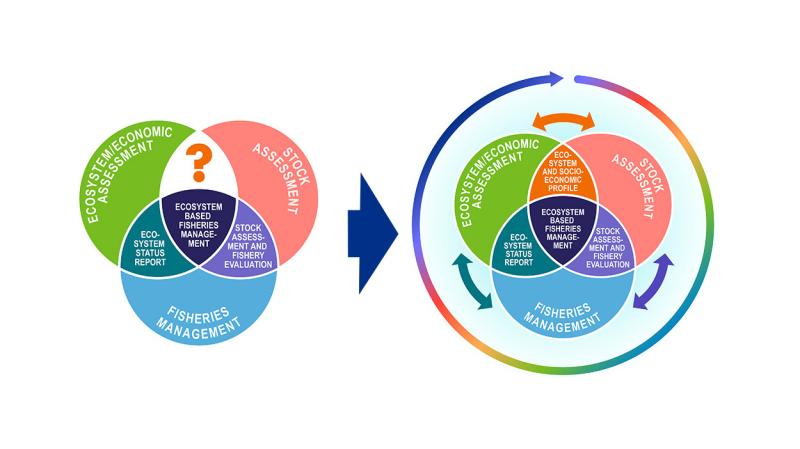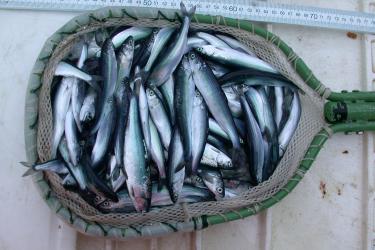NOAA Fisheries is committed to ecosystem-based management as our most powerful tool to maintain productive, resilient fisheries in a changing climate. This approach considers the entire ecosystem, including humans, to balance tradeoffs between ecological, social, and economic needs.
A new tool, the Ecosystem and Socioeconomic Profile (ESP), takes a significant step toward the application of ecosystem-based fisheries management. It facilitates the integration of ecosystem and socioeconomic information into fisheries management decisions. This rapid communication tool distills information from a variety of sources into a succinct, focused report to help resource managers in their decision-making. Developed in Alaska, it is being adapted and adopted across the nation.
“The ESP gives managers a streamlined version of what affects each fish stock. It provides a means to get a broad range of information—from articles, workshops, citizen science, traditional indigenous knowledge—into one place,” said NOAA Fisheries biologist Kalei Shotwell, Alaska Fisheries Science Center, who initiated the development of the ESP. “It moves us toward ecosystem-based fisheries management. That’s the ultimate goal.”
Evolution of the Ecosystem and Socioeconomic Profile
The ESP was first conceived in 2014, building on NOAA Fisheries’ rich history of identifying ecosystem and socioeconomic pressures since the 1990s.
“We had a lot of information at the large marine ecosystems level. But we don’t manage fish at that level. There was a communication gap between conducting research and getting the information into management advice for individual fish stocks,” said Shotwell. “We developed the ESP to fill that gap.”
The first ESP case study using Alaska sablefish was completed in 2017. Over the next several years, it was developed and refined through the North Pacific Fisheries Management Council review process and using recommendations from the 2018 NOAA Fisheries’ Next Generation Stock Assessment Improvement Plan. The ESP was further honed through a series of workshops with representatives from:
- Alaska and other NOAA Fisheries Science Centers and offices
- North Pacific Fisheries Management Council
- Stakeholder advisory panels
- International Pacific Halibut Commission
- Alaska Department of Fish and Game
"We needed everyone’s buy-in to be successful. We had grassroots support and a concerted effort by experts across disciplines, all working together,” Shotwell said.
ESPs have been completed for several Alaska crab and groundfish stocks since 2019. These include some of the nation’s largest and most valuable fisheries: Alaska pollock, Pacific cod, red king crab, and snow crab.
“It has been a long road developing and improving ESPs, but now we are in a place for production” Shotwell said. “The ESP now completes the loop between stock assessment, ecosystem and socioeconomic assessment, and fisheries management.”
A Four-Step Process
The ESP integrates ecosystem and socioeconomic factors into the stock assessment process through a four-step process.
Step 1: Focus on Ecosystem and Socioeconomic Priorities
Review information from the national initiatives and regional priorities to determine if a fish stock is a priority for producing an ESP.
Step 2: Synthesize Ecosystem and Socioeconomic Vulnerabilities
Identify vulnerabilities to overfishing, ecological pressures, and climate change throughout the life stages of the stock; combine with ecosystem and socioeconomic processes driving stock dynamics.
Step 3: Analyze Ecosystem and Socioeconomic Indicators
Create and monitor a suite of indicators of the health of the stock and fishery. For example, for sablefish there was an increase over the past 20 years in ecosystem indicators producing good conditions for sablefish. But a subsequent downturn in socioeconomic indicators as prices dropped and bycatch increased with the influx of small sablefish.
Step 4: Communicate Ecosystem and Socioeconomic Considerations
The final step culminates in a report that concisely conveys the status of leading indicators for a given stock to fisheries managers.
Inclusivity: Making Voices Heard
Among the benefits of the ESP is that it provides a way to include information from a variety of sources, including fishermen and communities.
“Now we have a consistent way to incorporate public comment and skipper surveys. In the future, we hope to meet with Alaska Native groups that may want to provide information on what stocks are important to them, and what indicators may be helpful to monitor,” Shotwell said. “The ESP provides an avenue for underrepresented stakeholders to communicate their needs. It’s making people’s voices heard.”
Ecosystem and Socioeconomic Profiles in Action
The ESPs have already been used in several management applications for crab and groundfish stocks in the North Pacific region. For example, they have helped estimate risk for sablefish, pollock, and Pacific cod. They informed rebuilding plans for St. Matthew Island blue king crab and Bristol Bay red king crab stocks. ESP indicators will continue to be an important monitoring tool during the rebuilding process.
Shotwell notes that while ESPs are now ready for use in ecosystem-based fisheries management, each will be evaluated and updated annually to reflect changing conditions.
“You can’t just set it and forget it,” Shotwell said. ”It is an evolving process that needs to be evaluated and updated. That is why we know ESPs will provide the best and most current scientific information."
The team has seven more ESPs on track to develop for Alaska. These stocks are high priority stock stocks recommended by the science center and the North Pacific Fishery Management Council.
“And now we are going national with dedicated workshops to share ESP development across the country. We hope to expand this to site visits in the near future. That will be the true test of how applicable the ESP is. We’ve developed the foundation. It’s malleable. It can be adapted. Exactly how it plays out will be different in each region,” Shotwell said. “We used Alaska data to create a tool for everyone."
The development of the first ESP manuscript was a collaborative effort between NOAA Fisheries Alaska Fisheries Science Center (K. Shotwell, E. Fedewa, D. Hanselman, K. Aydin, O. Ormseth, P. Spencer, S. Zador), NOAA Fisheries Office of Science and Technology (K. Blackhart, B. Fissel, P. Lynch), University of Alaska Fairbanks (C. Cunningham), University of Washington (M. Doyle).








